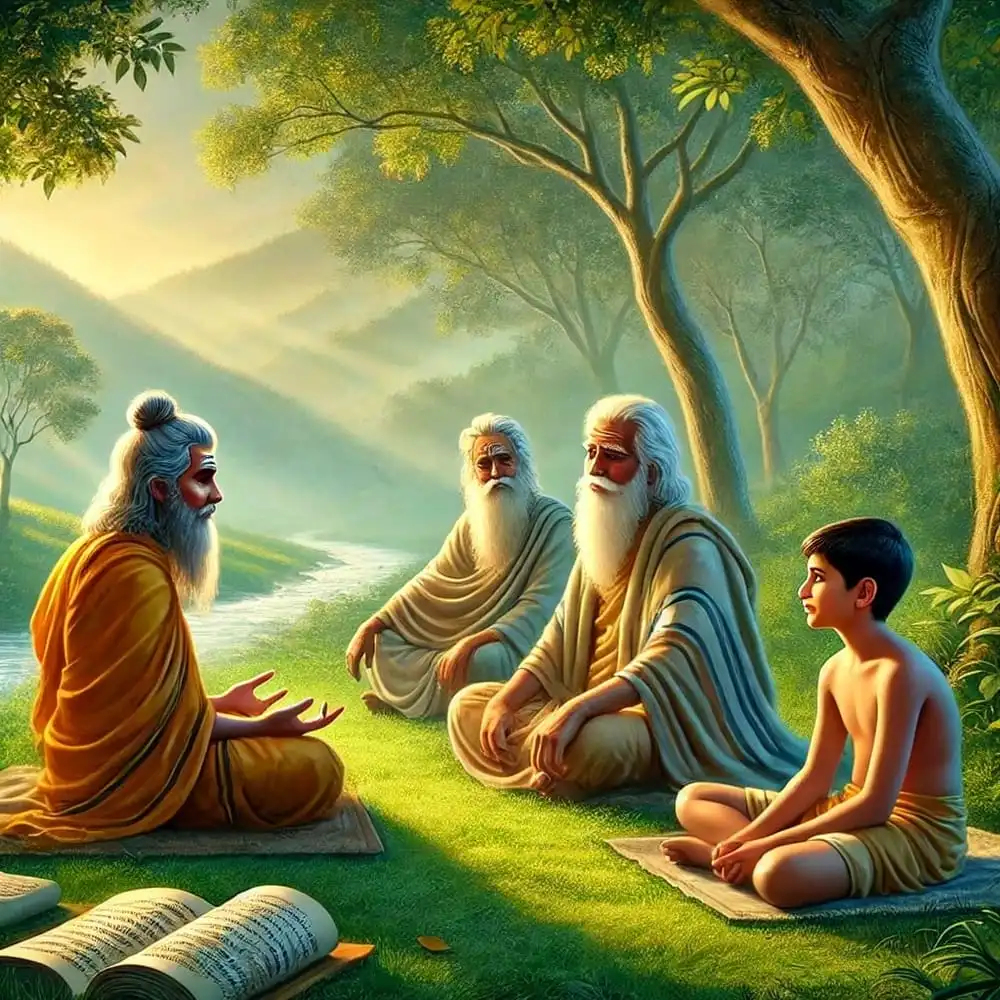The Srimad Bhagavatam is one of the most revered Hindu texts that stands as a testament to the enduring power of devotion and the timeless quest for spiritual enlightenment. Its teachings on selfless love, detachment from material pursuits, and the supreme nature of devotional service resonate with spiritual aspirants across the globe.
The Srimad Bhagavatam story begins in the forest of Naimisharanya, where 88,000 sages led by Shaunak Rishi posed six fundamental questions to their spiritual teacher, Suta Goswami, followed by inquires of the origin of the Srimad Bhagavatam. This blog explores how the Srimad Bhagavatam was written, delving into the stories of the key figures involved in its creation and the context of its writing.
The Journey of Wisdom
After receiving profound wisdom from Suta Goswami, the sages expressed their gratitude and inquired about the origins of the Srimad Bhagavatam. Suta Goswami shared that he learned the wisdom of the Srimad Bhagavatam from his spiritual teacher, Shukadev. The sages were surprised, pointing out that Shukadev was a renounced saint who only visited householders for the duration a cow was being milked.

The sages questioned how Shukadev came to know the Srimad Bhagavatam. Suta Goswami explained that Shukadev received this knowledge from his father, Ved Vyas. Intrigued the sages asked for the story of Veda Vyas prompting Suta Goswami to begin his narrative.
The Discontent of Ved Vyas
The Missing Element
At the heart of the Srimad Bhagavatam's creation lies a story of Divine discontent. Ved Vyas, the legendary sage credited with compiling the Vedas and authoring numerous sacred texts, found himself in a state of spiritual unrest despite his monumental achievements.
After composing the four Vedas, the epic Mahabharat (which includes the revered Bhagavad Gita), the Brahma Sutra, and seventeen Puranas, Ved Vyas felt an inexplicable void. His works, though vast and comprehensive, seemed to lack a crucial element that could truly touch the hearts of people. This feeling of incompleteness led him to a profound realization that he had yet to fully touch upon pure, selfless love for the Divine.

Inspiration and Guidance
It was in this moment of introspection that the celestial sage, Narad, appeared before Ved Vyas. Recognizing the great compiler's spiritual dilemma, Narad shared his journey of devotion, providing the inspiration and guidance that ultimately led to the writing of the Srimad Bhagavatam.
The Transformative Encounter
Narada's account of his spiritual journey serves as a powerful narrative within the larger story of the Srimad Bhagavatam's origin. In a past life, he had been a celestial being who, due to a curse, was reborn as the son of a maidservant.
Seeds of Devotion
During his childhood, he encountered a group of sages observing Chaturmas, the four months of monsoon, in which spiritual seekers would gather in one place. He listened intently to their discussions on spiritual matters and partook of the blessed remnants of their meals. This simple service and association with holy men planted the seeds of devotion in young Narad's heart.

Solitary Quest and Divine Revelation
Following the departure of the sages and the untimely death of his mother which left him unmoored, Narad embarked on a solitary spiritual quest. His journey culminated in a momentary vision of Shree Krishna during meditation, an experience that fueled his lifelong pursuit of God. However after this glimpse, Shree Krishna vanished, leaving Narad yearning for more. His quest to recreate that blissful experience took him across holy lands, performing penance and spiritual practices, yet the divine presence eluded him.
Forty years later, as despair threatened to engulf him, he received a Divine message that reassured him that the initial vision was a gift of grace, urging him to prepare further for a deeper communion with the Divine. This profound experience culminated in Narad's next birth as a celestial sage, where he traveled the worlds, spreading the message of devotion to Lord Krishna.
Narad's encouragement resonated deeply with Ved Vyas. The sage understood that to write the Srimad Bhagavatam, he needed to embody the principles of love and devotion that Narad provided.
The Birth of the Srimad Bhagavatam
Divine Vision and Compassion
Ved Vyas began a rigorous process of meditation and austerity, seeking Divine vision before penning the new scripture. After experiencing a profound vision of the Divine, Ved Vyas was moved by compassion for the souls trapped in the material world that were unaware of their spiritual heritage. This compassion became the driving force behind his writing of the Srimad Bhagavatam, which was not merely a collection of stories but a heartfelt offering to the world.

The Srimad Bhagavatam thus emerged as Ved Vyas's magnum opus, a work that not only narrated the pastimes of Shree Krishna but also provided a comprehensive guide to spiritual awakening through the path of devotion. Its verses, imbued with the author's realizations, possessed the power to transform hearts and awaken dormant love for the Divine.
Passing the Torch: Shukadev's Role
Ved Vyas realized the importance of sharing his teachings, and understood he needed a youthful and energetic person to carry on his work, as he was aging. With this in mind, Ved Vyas chose his son, Shukadev, to take on the task of propagation of the Srimad Bhagavatam. In a past life, Shukadev was a parrot who had heard the Srimad Bhagavatam from Lord Shiva.
Conclusion
The writing of the Srimad Bhagavatam is a testament to the transformative power of Divine inspiration and the deep interconnectedness of spiritual seekers. From Ved Vyas’s initial discontent to his ultimate realization of the importance of Bhakti, the narrative serves as a guide for all on the spiritual path. It highlights that true knowledge is not merely intellectual but deeply experiential, arising from love, compassion, and the desire to uplift others.
FAQs
- Who is the author of the Srimad Bhagavatam?
The Srimad Bhagavatam is attributed to Ved Vyas, the sage who compiled the Vedas and other major Hindu scriptures. - What is the main theme of the Srimad Bhagavatam?
The central theme of the Srimad Bhagavatam is Bhakti (loving devotion) to God. It also explores various philosophical concepts and narrates numerous stories of devotees and Divine incarnations. - What role did Narad play in the creation of the Srimad Bhagavatam?
Narad served as a spiritual guide to Ved Vyas, sharing his own experience of devotion and inspiring Ved Vyas to compose a text that would emphasize the importance of selfless love for God. - Why is the Srimad Bhagavatam considered Ved Vyas's greatest work?
The Srimad Bhagavatam is seen as Vyas's crowning achievement because it synthesizes his vast knowledge and spiritual realizations into a work that not only imparts wisdom but also has the power to awaken devotion in its readers.
Related Resources
The six profound questions of Srimad Bhagavatam
The importance of Srimad Bhagavatam
Swami Mukundananda's Srimad Bhagavatam Video






